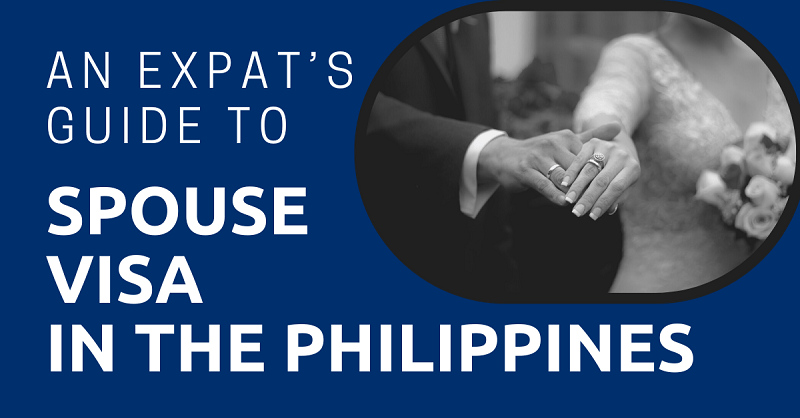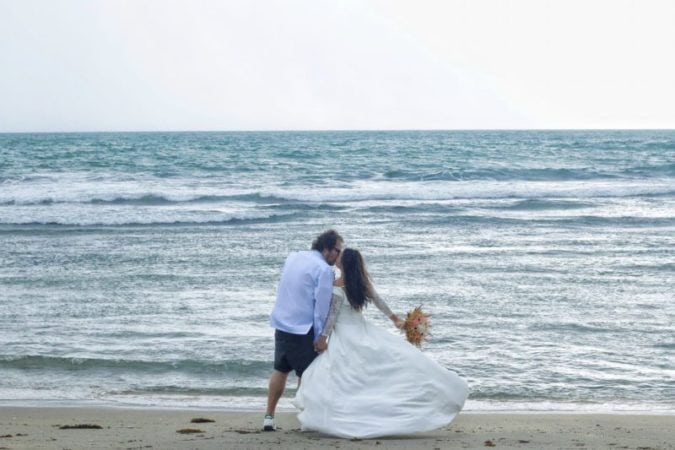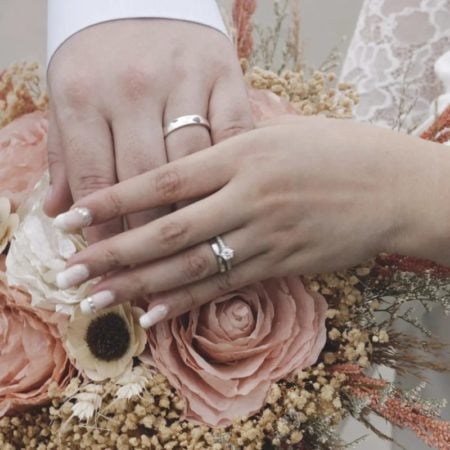
All expats living in the Philippines know that ‘it’s more fun in the Philippines’. Not only because it is the island nation’s unofficial slogan, but also because the country with its many beautiful travel destinations, delicious food, and welcoming locals is a fun and fantastic country to live in.
However, while the Philippines provides a stress-free and great life for several expats that have found love, it is not always fun when you have to deal with the authorities. And it’s often visa regulations that create problems for foreigners who want to settle down in the Philippines permanently, especially if you have a Filipino spouse.
Read further to get all the information you need to get an edge when applying for a marriage visa, also called 13A Non-Quota Immigrant Visa by Marriage.
This article will take approximately 15 minutes to read. Don't have the time right now? No worries. You can email the ad-free version of the article to yourself and read it later!
Disclaimer: This article may include links to products or services offered by ExpatDen’s partners, which give us commissions when you click on them. Although this may influence how they appear in the text, we only recommend solutions that we would use in your situation. Read more in our Advertising Disclosure.
Contents
- What is 13A Non-Quota Immigrant Visa?
- Benefits
- Types of Non-Quota Immigrant Visa
- Who Qualifies for a Marriage Visa?
- Requirements For the 13A Non-Quota Immigrant Visa
- Paperwork
- How to Apply for a Marriage Visa
- 13A Visa Philippines Cost
- How Often do I Need to Renew my 13A Visa?
- Do I Have to Apply Personally?
- Can I Apply Outside of the Philippines?
- Now, on to You
What is 13A Non-Quota Immigrant Visa?
A Marriage Visa in the Philippines is also called a 13A Non-Quota Visa. This visa type is issued to a foreign national who married a Filipino citizen.
Your Filipino spouse is the one who should petition for the visa on your behalf and while waiting for the approval of the visa, you can stay in the Philippines under a tourist visa and extend it if needed.
The 13A Non-Quota Visa will allow you to stay in the Philippines indefinitely as long as you remain married to your Filipino spouse.
The process of obtaining a 13A Non-Quota Visa usually takes 2-3 months from the complete submission of the required documents.
Once approved, you will get a one-year temporary visa (called a probationary visa in the Philippines). After one year, you can convert to a permanent visa.
Benefits
A marriage visa allows you to seek an indefinite stay and gain residence in the Philippines under the condition that you are a foreign national married to a Filipino citizen and that your marriage is valid according to Philippine Laws.
This means, that you can have a job without any special work permit and don’t have to do visa runs or keep on extending your visas over and over again.
With a marriage visa, you will be able to stay in the Philippines indefinitely provided the conditions of the visa are maintained. Which, among others means, that you maintain a valid marriage with a Filipino citizen, and don’t get deported or blacklisted for entry into the country.
However, while you as a permanent resident can enjoy a lot of the benefits local Filipinos enjoy, you are still not able to own land. The Philippine Constitution does not allow foreigners to own land no matter their residence status.
Still, you can work and get a tax identification card plus easier access to opening a bank account and getting loans.
Types of Non-Quota Immigrant Visa
There is only one type of marriage visa in the Philippines. And it is the so-called 13A Non-Quota Immigrant Visa by Marriage.
However, it can be probationary and permanent and while there is not a big difference between the two it’s important to know the differences before applying.
13A Probationary
If your application for the 13A visa is approved, you will be given a one-year probationary status.
After a year on probation, the Bureau of Immigration (BI) will re-evaluate your status to determine if you are qualified to have your visa converted to a permanent resident visa.
13A Permanent
As long as you maintain your marriage and uphold the marriage visa requirements, have a clean record at the Bureau of Immigration, and pass an NBI clearance, you will be able to upgrade your 13A probationary to a permanent non-quota immigrant visa by marriage after your one-year probation period.
Who Qualifies for a Marriage Visa?
To be granted a marriage visa in the Philippines, you need to legally marry a Filipino citizen. Unfortunately, homosexual couples, who married in a country where same-sex marriage is legal, aren’t able to get their marriage legalized in the Philippines and thus not able to apply for a marriage visa.

Requirements For the 13A Non-Quota Immigrant Visa
Before your visa application, there are certain criteria that you as a foreign national need to meet before you will be able to apply:
- Valid marriage with a Philippine citizen
- The marriage is recognized and valid according to Philippine laws
- You have no record of any derogatory violation against the spouse in any foreign or local law enforcement agency
- You are financially stable and able to support his/her family and will not become a public burden
- You don’t have any contagious or dangerous disease
- You have been allowed to enter and authorized to stay in the Philippines by the Bureau of Immigration
After you have met all the above-mentioned criteria, the next step in your journey to get a marriage visa is to prepare the necessary documents that you need to start the application process.
Paperwork
Below are the required documents you need to prepare when applying for the Philippines’ marriage visa:
1. Application form – two original and signed copies.
2. Joint letter addressed to the Commissioner of the Bureau of Immigration from the applicant and the petitioning Filipino spouse – one original and signed copy that needs to be notarized
3. Passport with at least six months of validity beyond the date of departure from the Philippines
4. Two photocopies of the passport information page of the applicant
5. Two photocopies of the passport information page of the applicant’s Filipino spouse
6. Original and photocopy of the applicant’s Filipino spouse’s birth certificate issued by the PSA (Philippine Statistics Authority)
7. Original and photocopy of the marriage certificate
- If you were married in the Philippines, the marriage certificate must be issued by the PSA (Philippine Statistics Authority)
- If the wedding was officiated in another country, the marriage needs to be registered with the Philippine Embassy or Philippine Consulate-General in the country where the marriage took place
- Moreover, if your Filipino spouse was engaged in a previous marriage before your marriage, you need to show proof of marriage annulment.
8. Valid NBI clearance from the National Bureau of Investigation in the Philippines, if you are applying for a marriage visa six months or more from the date of your first arrival in the Philippines
9. Four passport-size ID photos taken less than six months before applying for your marriage visa; you should wear decent attire and pictures should be taken against a white background
10. Prepare evidence of financial capacity to be able to live in the Philippines and support our family. This could be but is not limited to bank statements of accounts, employment contracts, and certificates of stock to show that you will not become a financial burden in the Philippines and that you can provide for your and your family’s needs. There is no set minimum amount of income as it’s on a case-by-case basis.
11. Affidavit of Joint Cohabitation written and signed by a lawyer: A statement that you have been living together under the same roof for a specified amount of years. It’s a simple document. You can use any lawyer in your in your area. This should cost no more than ₱350-500 (approximately US$6.27-9) depending on how urgent it is.
How to Apply for a Marriage Visa
After you have gathered all the required documents, it’s finally time to apply for your 13A marriage visa. It’s a rather straightforward process but can be time-consuming.
But with a little bit of patience and persistence, it should be manageable without any help from fixers or agencies.
1. Apply for NBI Clearance
Start your application process by getting an NBI clearance. Enter the required information (address, passport number, etc.) at NBI’s website and schedule an appointment at a local BI office close to where you live. Pay the NBI Clearance Multi-purpose fee, which is ₱130 (around US$2) + system fee ₱25 (US$0.43), totaling ₱155 (around US$3).
Print out the NBI clearance application form and bring this together with your payment slip on the appointed date.
On the appointment date, go to the NBI Clearance Office where you scheduled your appointment. Remember to wear proper attire, which means no shorts or slippers. Moreover, don’t forget to bring the following documents:
- Original and photocopy of your passport
- Original and photocopy of your ACR I-Card
- Print-out of the application.
- Official receipt of payment.
At the NBI Clearance Office, there’s a line dedicated to foreigners. Go there and get your documents checked. Afterward, go to the next clerk who will take your biometrics, digital signature, fingerprints, and picture.
The next step is to submit all the documents at a completely new station, where a kind officer will take your fingerprints once again and you need to sign all your documents.
After this, you will finally get your NBI Clearance receipt. The NBI officers will stamp it and
write a date on the back which indicates when you can claim your NBI clearance.
2. Visit the BI Office
After you get the NBI clearance, the next step is to download BI FORM V-I-002-Rev 1 ‘general instruction guide’ which gives you a checklist and information about what you will need to make your 13A visa request.
Then, you need to visit your preferred BI office. It’s recommended to schedule an online appointment at the BI’s website.
It’s still possible to go there without an appointment. But it could be a busy day and you could wait for hours just to start the whole time-consuming process.
3. Apply for Your Marriage Visa
Go to your preferred BI office at the scheduled date and time and remember to bring all the required documents.
The first thing you need to do is to submit all your documents for pre-screening at the CRU (Central Receiving Unit) or the frontline officer who will check if you have all the necessary documents.
After this you will be directed straight to a new window where you should do the following:
- Submit requirements for the 13A application,
- Submit requirements for the ACR I-Card application
Get the payment slip and pay the required fee. The total will be ₱12,000 (around US$204) and forget about Gcash, Credit Cards, or any other digital payment solution. Cash is always king when you deal with Immigration in the Philippines, so remember to bring enough cash.
4. Wait 3 Days and Go Back for Biometrics
Bring your payment slip and go back to the same immigration office after approximately 3 days. If in doubt please call ahead to check if they have time to see you. Here you will be required to take pictures and get your fingerprints captured for your ACR-I card.
5. Waiting Game Until Releasing
Now you just have to wait and stay updated on the BI’s official Agenda Verification website where you can check your visa application status. This process can take 1-2 months and as soon as your file number shows on one of their agendas you need to go to the same immigration office again.
Here you will hand over your passport to get your temporary marriage visa. Then you need to wait a couple of days and go back to the BI office and pick up your ACR I-card and collect your passport with your new visa probationary marriage visa.
6. Upgrade to a Permanent Visa After 1 Year
After a year, you can upgrade your visa to a permanent visa. The process is the same as when you apply for a marriage visa for the first time.
If you uphold the marriage visa requirements, have a clean record at the Bureau of Immigration, and pass an NBI clearance, you should be able to get the permanent marriage visa without any problem.
However, it’s important to point out that you should file for an amendment from probationary to permanent 13A visa 3 to 4 months before the expiry date of your probationary visa. This will allow you enough time to process the visa application and avoid overstaying.

13A Visa Philippines Cost
The total fee for the 13A marriage visa in the Philippines is as follows:
- NBI clearance: ₱130 (around US$2) + system fee ₱25 (around US$0.43)
- Visa processing fee (probationary): ₱8,620 (around US$147)
- Additional Fee for ACR I-Card: US$50
- Visa processing fee (permanent): ₱8,620 (around US$147)
If you do not include waiting time, payment for taxis, and so forth. The total fee for a permanent 13A marriage visa in the Philippines is approximately ₱20,000 (around US$340).
How Often do I Need to Renew my 13A Visa?
One of the most significant advantages of a 13A marriage visa compared to any other visa type in the Philippines is that you don’t have to renew it.
Once the Bureau of Immigration approves your application from probationary to permanent 13A non-quota immigrant visa by marriage, you will be able to stay in the Philippines without renewing your visa.
However, you will need to file an annual report in person at the Bureau of Immigration’s main office in Intramuros in Manila or one of the nearest participating BI offices within the first 60 days of each calendar year.
The annual report (AR) costs ₱310 or approximately US$5.50. Additionally, you will need to renew your ACR-I Card (Alien Certificate of Registration) every five years, costing US$50 or approximately ₱3,000.
Do I Have to Apply Personally?
Getting a marriage visa in the Philippines is a rather straightforward process. However, it can be time-consuming and soul-wrenching, which is why many expats prefer to use an agency to do all the legwork for them.
However, this comes with a price, and depending on the agency you choose you can expect to pay everything from ₱30,000-₱70,000 (around US$510-US$1,190) to get well-connected local experts to handle everything for you.
You still have to show up personally and do the NBI clearance yourself, go to the immigration office when needed, and sign all the required documents. But it will save you a lot of time and potential headaches if an agency can take care of checking all the requirements and booking appointments for you.
There are a lot of agencies available online, and most of them have offices located around the BI office. But your best bet would be to ask for recommendations from fellow expats who have used a reputable agency with successful results. Most expats have online forums or also have Facebook groups such as Expats Philippines, Expats in the Philippines, Filipinos and Expats Forum, and many others.
Can I Apply Outside of the Philippines?
If you have been married abroad or just living abroad with your Filipino spouse, it’s possible to apply for a 13A marriage visa outside of the Philippines if you are living in a country with a Philippine Consulate or embassy.
The requirements, cost, and process are the same. The main difference is that it’s less time-consuming and that you don’t need an NBI clearance. Instead, you as a foreign spouse of a Filipino national, need an apostilled local police clearance obtained within the last (6) months.
Moreover, instead of visiting the Philippine Consulate or embassy, you can submit your documents and visa application by mail or courier service, which makes it a less time-consuming process.
Now, on to You
It’s more fun in the Philippines, and with a marriage visa, your life in this beautiful island nation could become even more joyful and stress-free.
While it can be a rather time-consuming process, you will be able to work without a work permit, don’t need to do visa runs or extend your visas all the time, and will have easier access to opening a bank account.
To get started in finding your one true Filipina love, we recommend checking out the Expat’s Guide to Dating Sites in the Philippines.








I paid and did all the paperwork and got the 13a stamped on my passport but then every 13 a has to go to the Bureau of Quarantine where they require you to get the covid 19 vaccine and booster. They also require you to get the long banned in the USA polio vaccine. I asked for a religious and medical exemption and they said no way. I asked for my money back being that no one told me this was going to be a requirement. They said no and that it was on the website, but it was not on the Philippines Embassy website or checklists nor on the Bureau of Immigration website. And I read everything before I applied. I was surprised they don’t make regular tourists get the jab but they want to jab the spouses. I normally don’t write on comments. But maybe this will save some one thousands of dollars.
Hi Dave,
Thanks a lot for the comment. And yeah, dealing with the Philippines immigration office isn’t fun at all 🙁
Can a foreigner with marriage visa be allowed to be the president of a company in the Philippines?
Yes, you can do that. However, you will still need to obtain a work permit. Additionally, your company should not operate within an industry that restricts foreign ownership, such as media, retail trade, etc.
This site is so helpful I can’t thank you enough! After travelling to / from the Philippines for the last 9 years I’ve decided to retire here permanently